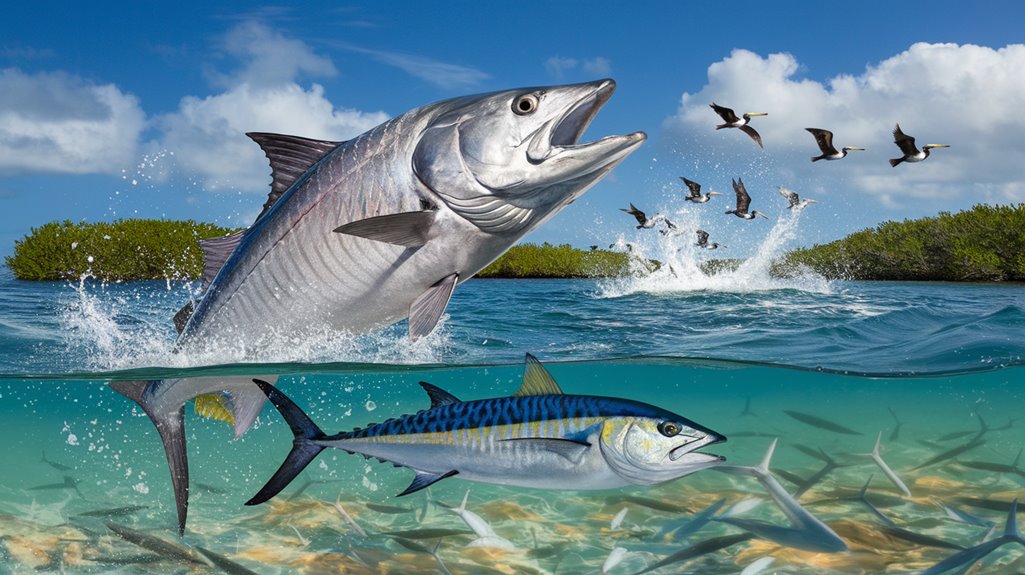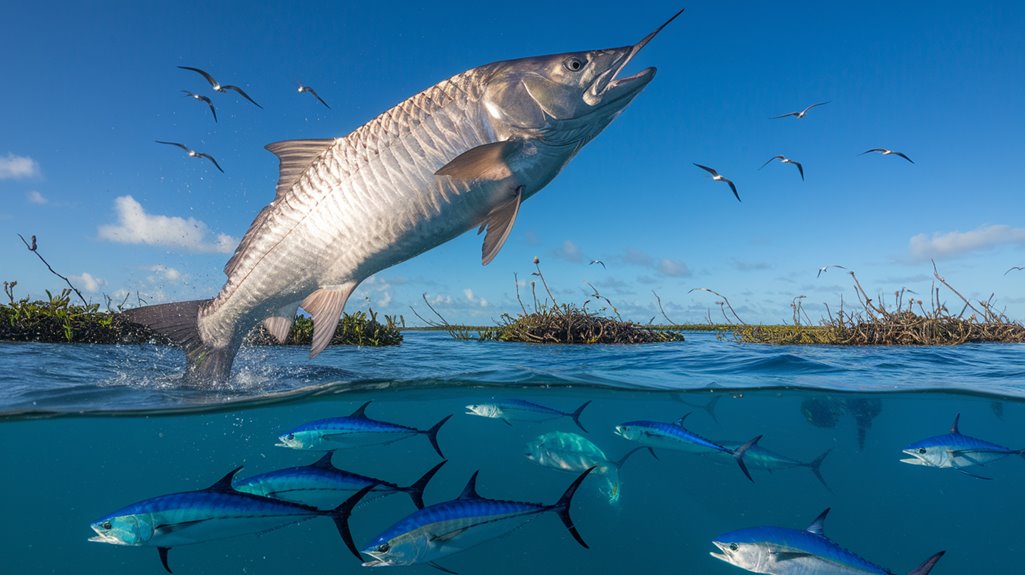While you're pursuing the silver king, you'll discover that tarpon waters hold an impressive array of gamefish ready to test your skills. Beyond the rolling pods of tarpon, you'll find blackfin tuna slashing through bait schools and mahi mahi patrolling the weed lines just a few hundred yards away. Understanding how these species interact and overlap can transform your single-species mission into a multi-species adventure that maximizes your time on the water.
- Key Takeaways
- Prime Offshore Species That Share Tarpon Waters
- Essential Gear for Multi-Species Fishing
- Best Seasonal Timing for Combined Catches
- Top Fishing Techniques for Mixed-Species Success
- Hotspots Where Tarpon Meet Pelagics
- Weather Patterns and Fish Movement
- Bait Selection for Diverse Species
- Tournament Strategies for Multiple Target Species
- Frequently Asked Questions
- Conclusion
Key Takeaways
- Amberjack and blackfin tuna share coastal waters with tarpon, making them excellent secondary target species during tarpon fishing trips.
- Mahi mahi frequently inhabit the same offshore areas as tarpon, especially near weed lines and floating debris.
- Blue marlin can be found patrolling areas where tarpon schools gather, offering opportunities for trophy gamefish.
- Snapper and grouper occupy similar depth ranges as tarpon, providing bottom-fishing options while targeting surface species.
- Wahoo are commonly encountered near floating debris and weed lines where tarpon feed, especially during morning hours.
Prime Offshore Species That Share Tarpon Waters
While tarpon may be your primary target, their waters teem with other prized gamefish that'll make any offshore trip memorable. You'll find pelagic species like amberjack and blackfin tuna sharing the same warm coastal waters, especially during migration seasons. Keep an eye out for wahoo near floating debris and weed lines, where they're known to strike with incredible speed and put on acrobatic displays.
When you're working these productive waters, you might encounter the magnificent blue marlin patrolling the same areas as tarpon schools. Don't be surprised if you spot the vibrant colors of mahi mahi darting through these waters as well. For structure-oriented fishing, you'll discover snapper and grouper inhabiting the same depths where tarpon frequently cruise, offering diverse catching opportunities throughout your day.
Essential Gear for Multi-Species Fishing
Successful multi-species fishing in offshore waters demands specific gear choices that'll give you the versatility to tackle both tarpon and their pelagic neighbors. You'll need a medium to heavy action rod paired with a high-drag reel to handle powerful runs from both tarpon and offshore species like mahi mahi and marlin.
Equip your arsenal with fluorocarbon leaders in the 30-80 lb test range, which provide the perfect balance of stealth and strength. Stock your tackle box with trolling plugs, jigs, and surface poppers to adapt to changing conditions. Don't overlook live bait options – keeping pilchards and threadfin shad in your baitwell is essential when targeting multiple species. For maximum effectiveness, mount a quality fish finder to locate schools and identify productive thermoclines where your target species concentrate.
Best Seasonal Timing for Combined Catches
Since pelagic species and tarpon share similar migration patterns, you'll find your best opportunities for combined catches during the warmer months from late spring through early fall. You'll maximize your success by targeting prime feeding times during early morning and late afternoon hours.
| Season | Target Species Combinations |
|---|---|
| Spring | Tarpon + Mahi Mahi |
| Early Summer | Tarpon + Blackfin Tuna |
| Mid-Summer | Tarpon + Cobia |
| Late Summer | Tarpon + Snapper |
| Fall | Mixed Migration Species |
To optimize your seasonal migrations strategy, focus on artificial reefs and wrecks where multiple species congregate. Live bait proves especially effective during these peak periods. Keep track of local fishing reports to pinpoint the best times for mixed catches, particularly as species begin grouping up before cooler weather arrives.
Top Fishing Techniques for Mixed-Species Success
You'll maximize your mixed-species success by free-lining live baits like threadfin herring and pilchards, which attract both tarpon and pelagic species in the 50-150 meter depth range. Your bait selection strategy should include slow-trolling with bright lures when targeting wahoo and tarpon simultaneously, especially near visible bait balls and bird activity. For the most rewarding experience, opt for light tackle that'll let you fully appreciate the power of these fish while maintaining the technical challenge of working multiple species.
Targeting Multiple Fish Species
Anglers seeking multiple species during offshore trips can maximize their success by employing versatile techniques that appeal to various pelagic fish. You'll find that free-lining live baits like Threadfin Shad and Pilchards proves effective for both tarpon and other pelagic species, especially in clear waters. Focus your efforts near structure and along beaches during outgoing tides, where you're likely to encounter mixed schools of snook and grouper alongside tarpon.
For offshore success, slow-troll larger baits near floating debris and weed lines where mahi mahi and wahoo congregate. Time your fishing during early mornings or late afternoons when activity peaks, and pay attention to temperature breaks that indicate prime feeding zones. These fishing strategies help you target multiple species efficiently while adapting to local conditions.
Bait Selection Strategy Tips
Selecting the right bait combinations stands at the heart of successful mixed-species fishing strategies. When you're offshore fishing for pelagic species alongside tarpon, you'll want to focus on versatile live bait options that attract multiple target species. Free-line your baits during slow tides and adapt your bait presentation based on water conditions.
| Bait Type | Target Species | Best Conditions |
|---|---|---|
| Threadfin Shad | Tarpon, Tuna | Morning/Evening |
| Pilchards | Tarpon, Wahoo | Swift Tides |
| Menhaden | Tarpon, Grouper | Deep Water |
| Live Crabs | Tarpon, Permit | Outgoing Tides |
Remember to monitor water temperatures and seasonal patterns to maximize your success. You'll find that slow-trolling with varied baits increases your chances of hooking multiple species, while proper rigging techniques guarantee effective presentations in different conditions.
Hotspots Where Tarpon Meet Pelagics

While many fishermen focus exclusively on either tarpon or pelagic species, you'll find these fish often share the same prime hunting grounds. The warm waters of the Florida Keys offer exceptional opportunities where you can target both, especially around offshore wrecks and reefs where nutrient-rich upwellings attract baitfish.
You'll want to focus your fishing techniques during peak feeding times at dawn and dusk, when tarpon congregate alongside blackfin tuna and wahoo. These spots become particularly productive during seasonal migrations, creating a perfect storm for multiple species action. Using live threadfin herring or slow-trolling near structure maximizes your chances of success. The deep water edges where these species intersect are goldmines, especially when you find the right combination of water movement and bait presence.
Weather Patterns and Fish Movement
Understanding weather patterns is essential for successful pelagic fishing, as these atmospheric conditions dictate fish movement and feeding behavior. You'll notice increased activity during frontal passages, when changes in atmospheric pressure trigger feeding responses. Watch for elevated water temperatures, especially in spring and summer, as they drive migratory patterns of pelagics and tarpon seeking ideal feeding grounds.
Pay attention to the lunar phase, as full moons create prime conditions for pelagic species' activity due to enhanced visibility. While storms might temporarily disrupt fishing, they often lead to productive post-storm opportunities when baitfish become more active. Track sea surface temperatures carefully – these warm-water patches are reliable indicators of where you'll find concentrating pelagics. By monitoring these weather conditions, you'll greatly improve your chances of successful offshore encounters.
Bait Selection for Diverse Species
When choosing between live and dead bait for pelagic species, you'll find that live options like Threadfin Shad and Pilchards create more natural movement that triggers predatory instincts. Your presentation must mimic the natural behavior of prey species, whether you're targeting surface-feeding Mahi Mahi or bottom-dwelling Grouper. While dead bait can work in certain situations, live bait's authentic swimming action and scent trail will consistently produce better results across diverse species.
Live Versus Dead Bait
As you venture into offshore waters, selecting between live and dead bait can considerably impact your success rate with pelagic species. For actively hunting fish like tarpon and barracuda, you'll find live bait such as Threadfin Shad and Pilchards particularly effective due to their natural movement and scent trails. When bottom fishing for grouper and snapper, dead bait often proves superior, as the sustained scent dispersion attracts these species more effectively.
Your target species should dictate your bait choice. While live bait triggers faster strikes from mahi mahi and blackfin tuna, dead bait works well when trolled at various depths. Remember to match your bait size appropriately – smaller offerings for bonefish and permit, larger ones for trophy tarpon and grouper.
Natural Presentation Matters Most
Natural presentation of bait serves as the foundation for successful offshore angling across multiple species. You'll find that using live bait like Threadfin Shad and Pilchards greatly improves your catch rates when targeting both tarpon and pelagic species. In coastal waters, it's vital to match your presentation to the natural feeding patterns of your target species.
| Species | Preferred Bait | Presentation | Location |
|---|---|---|---|
| Tarpon | Live Shad/Crabs | Surface/Mid | Coastal |
| Mahi Mahi | Live Pilchards | Surface | Weed Lines |
| Grouper | Live Baitfish | Bottom | Reefs |
| Amberjack | Fresh Live Bait | Mid-Water | Debris |
Understanding seasonal bait migrations and presenting natural bait presentations at varying depths will greatly enhance your success when targeting multiple species simultaneously.
Tournament Strategies for Multiple Target Species
Successful tournament fishing demands a strategic approach when targeting multiple species, particularly when combining pelagic and coastal species like tarpon, blackfin tuna, and wahoo. You'll need to master different techniques simultaneously, like slow-trolling offshore waters while maintaining live bait setups for tarpon in shallower areas.
Stay informed about weather patterns and seasonal movements to position yourself effectively. You'll find tarpon typically inhabiting coastal waters while pelagic species roam further offshore. Connect with local charter captains and experienced anglers to gather real-time intelligence about fishing conditions and hot spots. Adapt your presentation methods throughout the tournament – switch between live bait for tarpon and artificial lures for pelagics as conditions dictate. This flexible approach maximizes your chances of tournament success across multiple target species.
Frequently Asked Questions
How Far Offshore Are Tarpon?
You'll find tarpon within a few miles of the coastline, though they're most commonly caught inshore. When they do venture offshore, they typically stay within 10-15 miles of shore.
Can You Catch Tarpon Inshore?
You'll find excellent inshore tarpon fishing in shallow bays and coastal waters, especially during migrations. They're commonly caught around Florida's flats, passes, and mangroves using live bait or artificial lures.
Is Tarpon Fishing Offshore?
While 90% of tarpon catches occur inshore, you'll rarely find them offshore. You'll have your best luck targeting them in coastal waters, passes, and bays where they naturally feed and migrate.
What Is the Difference Between Atlantic and Pacific Tarpon?
You'll find Atlantic tarpon grow much larger, reaching 286 pounds, while Pacific tarpon max out at 110 pounds. They're found in different oceans and exhibit distinct migration patterns along their respective coastlines.
Conclusion
You'll find yourself chasing tarpon only to be "rudely interrupted" by a 50-pound wahoo – such is the delightful chaos of offshore fishing. Don't fight it; embrace the mayhem. Pack your versatile gear, trust those weather patterns, and remember: when you're telling stories at the dock, nobody needs to know you were actually targeting something else. That's the beauty of mixed-species fishing – success is practically inevitable.

